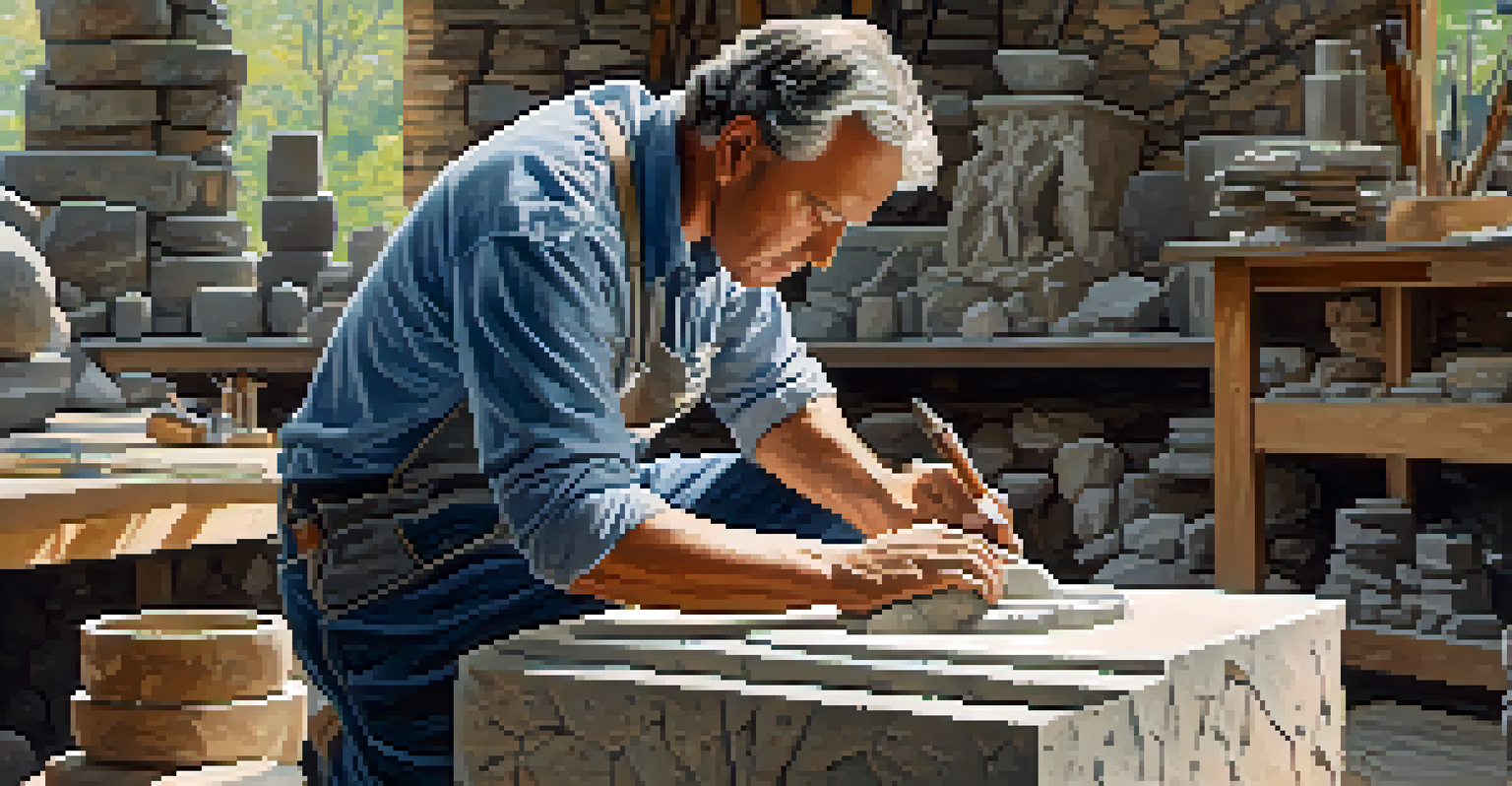Outdoor Sculpting: Techniques for Weather-Resistant Art

Understanding Weather-Resistant Materials for Sculpting
When it comes to outdoor sculpting, the choice of materials is crucial. Weather-resistant materials like stone, metal, and certain plastics can stand up against the elements. For instance, granite sculptures can endure rain and snow while maintaining their aesthetic appeal over time.
Art is not freedom from discipline, but disciplined freedom.
In contrast, softer materials like clay or plaster may deteriorate quickly when exposed to moisture or UV rays. It's essential to select the right material based on your sculpture's environment. By understanding the properties of various materials, you can create art that not only looks great but lasts longer.
Ultimately, choosing the right material is the first step toward ensuring your outdoor art withstands the test of time. Knowledge of these materials allows artists to make informed decisions, leading to more durable and resilient sculptures.
Essential Techniques for Creating Durable Sculptures
Once you've selected your materials, it's time to consider the techniques you'll use to create your sculpture. Techniques such as carving, welding, or assembling can significantly impact the final product's durability. For example, welded metal sculptures tend to be more robust than those assembled with glue or adhesives.

Moreover, understanding the techniques specific to your chosen material can enhance the longevity of your work. For instance, using appropriate chisels for stone carving can help achieve a cleaner finish while minimizing the risk of cracks or chips over time.
Select Weather-Resistant Materials
Choosing materials like granite or metal ensures your outdoor sculptures can withstand harsh weather conditions.
Incorporating robust construction techniques is essential for outdoor sculptures. This not only ensures stability but also allows the artwork to endure harsh weather conditions without compromising its integrity.
The Importance of Surface Treatments and Coatings
Surface treatments play a vital role in protecting your outdoor sculptures from the elements. Applying sealants, for instance, can help repel water and prevent damage from frost and UV rays. For metal sculptures, a good coat of rust-resistant paint can make all the difference in longevity.
The best artist has no conception that a marble block does not contain within itself, but only the skill to reveal it.
Different materials require different treatments, so it's essential to research what works best for your chosen medium. For example, porous stone may benefit from a penetrating sealant, while wood sculptures may need varnish to shield against moisture and insects.
By investing time in surface treatments, you can significantly extend the life of your outdoor art. Proper care not only preserves aesthetics but also enhances the sculpture's resilience against natural wear and tear.
Planning for Drainage and Moisture Management
One often-overlooked aspect of outdoor sculpting is drainage and moisture management. Proper planning can prevent water accumulation around your sculpture, which could lead to cracking or erosion. For instance, creating a slight slope in the base of your sculpture can help direct rainwater away.
Additionally, placing sculptures on a raised platform or using gravel can also enhance drainage. This proactive approach will protect your artwork from prolonged exposure to standing water, which can be detrimental over time.
Utilize Proper Techniques for Durability
Employing techniques such as welding or using appropriate chisels can greatly enhance the longevity of your sculptures.
By considering drainage in your design, you can ensure that your outdoor sculptures remain stable and intact, regardless of the weather conditions. This thoughtful planning contributes greatly to the longevity of your artistic creations.
Choosing the Right Location for Your Sculpture
The location of your outdoor sculpture is just as important as the materials and techniques you choose. Consider factors such as sunlight, wind, and proximity to trees, as these can influence the sculpture's longevity. For example, placing a sculpture in direct sunlight may fade its colors faster than a shaded area.
Additionally, be mindful of how nearby trees can impact your sculpture. Falling branches or sap can damage your artwork over time, so it's wise to analyze the surrounding environment before installation. Choosing a site with the right balance of light and protection can help preserve the integrity of your sculpture.
Ultimately, selecting the right location can enhance the overall aesthetic and ensure the durability of your outdoor art. A well-placed sculpture not only looks great but also enjoys a longer life in the elements.
Maintenance Tips for Outdoor Sculptures
Even the most durable outdoor sculptures require some maintenance to keep them looking their best. Regular cleaning is essential, as dirt, grime, and organic matter can accumulate and cause damage over time. A gentle wash with soap and water can often do wonders for restoring the sculpture's appearance.
Inspecting the sculpture for signs of wear, such as cracks or rust, is another key maintenance tip. Addressing these issues promptly can prevent further deterioration, ensuring that your art remains vibrant and intact. For metal sculptures, touch-up paint can be a quick fix to combat rust spots.
Prioritize Maintenance and Location
Regular maintenance and careful selection of the sculpture's location can significantly extend its lifespan and aesthetic appeal.
By committing to regular maintenance, you can prolong the life of your outdoor sculptures. This ongoing care not only enhances their beauty but also demonstrates respect for the artistry that went into creating them.
Inspiration: Famous Outdoor Sculptures and Their Techniques
Looking at famous outdoor sculptures can provide valuable inspiration and insight into effective techniques. Take, for example, the iconic 'Cloud Gate' by Anish Kapoor in Chicago. Its polished stainless steel surface not only dazzles but also showcases the resilience of high-quality materials against weather elements.
Another example is 'The Kiss' by Gustav Vigeland in Norway, which is carved from granite and has stood the test of time thanks to its sturdy construction and thoughtful location. Observing how these artists approached their work can help you understand the importance of planning and execution in outdoor sculpting.

By studying renowned sculptures, you can glean techniques and ideas that will inform your own creations. This exploration can spark creativity and encourage you to experiment with materials and methods that embody durability and beauty.